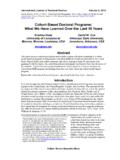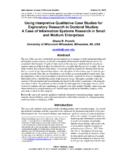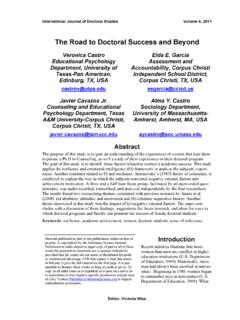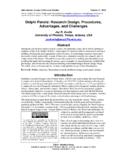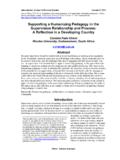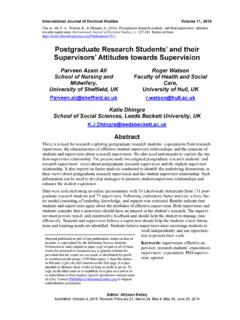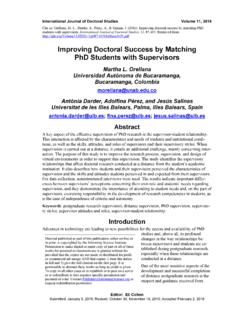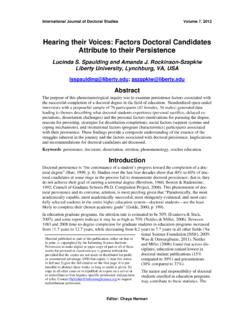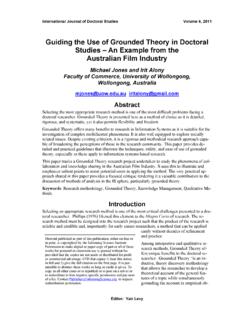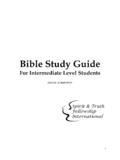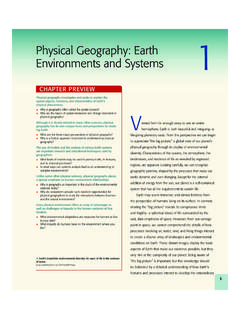Transcription of Striving to Obtain a School-Work-Life Balance: The …
1 International Journal of Doctoral Studies Volume 8, 2013 Striving to Obtain a School-Work-Life balance : The Full-Time Doctoral Student Edna Martinez, Chinasa Ordu, Matthew R. Della Sala, and Adam McFarlane Clemson University, Clemson, SC, USA Abstract The purpose of this study was to explore the doctoral student experience in relation to their school - work -lives. Through a grounded theory research design we sought to explore the follow-ing research question: How, and to what extent, do full-time doctoral students strive to Obtain School-Work-Life balance ?
2 Data were collected through semi-structured interviews and participant observations with five full-time doctoral education students who held one or more graduate assis-tantships on campus. From the data, we constructed four themes. Full-time doctoral students strived to achieve a School-Work-Life balance by (a) purposefully managing their time, priorities, and roles and responsibilities; (b) seeking well-being by managing stress levels, maintaining their mental and physical health, and creating personal time; (c) finding support from various individu-als and their institution; and (d) making tradeoffs.
3 Additionally, we found that single students with no children faced more challenges in efforts to Obtain a School-Work-Life balance in compari-son to their peers with families. Based on our findings, programs can facilitate degree attainment for students by continuing to provide financial support, flexibility in school and work schedules, and support services tailored to specifically address doctoral student needs. Lastly, our partici-pants stories may resonate with other doctoral students, and thus, may help them think about ways to attempt to balance their work and personal lives.
4 Keywords: doctoral students, doctoral student School-Work-Life balance , doctoral student attri-tion, grounded theory Introduction Doctoral level education in the United States is considered to carry significant public and private benefits. For example, as students reap social and financial rewards associated with their degrees, which utlimately extend beyond the individual (Baum, Ma, & Payea, 2010), doctoral degree production enables the country to remain globally competitive (Wendler et al., 2010).
5 Additionally, doctoral recipients respective colleges and universities garner prestige (Morphew & Huisman, 2002; O Meara, 2007). In terms of doctoral degree production in the United States Wendler et al. (2010) noted: The US has produced the vast majority of doctoral degrees conferred around the globe. Our graduate schools and their research facilities have been consistently Material published as part of this publication, either on-line or in print, is copyrighted by the Informing Science Institute.
6 Permission to make digital or paper copy of part or all of these works for personal or classroom use is granted without fee provided that the copies are not made or distributed for profit or commercial advantage AND that copies 1) bear this notice in full and 2) give the full citation on the first page. It is per-missible to abstract these works so long as credit is given. To copy in all other cases or to republish or to post on a server or to redistribute to lists requires specific permission and payment of a fee.
7 Contact to request redistribution permission. Editor: Michael Jones School-Work-Life balance ranked among the best in the world ( , the Times of London Rankings and the Shanghai Jiao Tong University Rankings), and from 1997 to 2009 over half of the Nobel Prize winners in chemistry, physics, medicine, and economics had received their graduate de-grees in the US. (p. 2) Nevertheless, these achievements are marred by high student attrition rates. Of the number of students enrolled in doctoral programs across colleges and universities, successful degree completion is unlikely for approximately 50% (Jairam & Kahl, 2012; Walker, Golde, Jones, Bueschel, & Hutchings, 2008).
8 Previous studies centered on doctoral students have identified national attrition rates ranging from 40 to 60% and varying by field of study (Bair & Haworth, 2005; Council of Graduate Schools, 2008; Di Pierro, 2007; Walker et al., 2008). Identified as the central issue in doctoral education in the United States today (Smallwood, 2004, para. 8), doctoral student attrition has led to a number of concerted efforts to counter student depature (Gardner, 2009). Despite programmatic and institutional efforts to support and retain doctoral students (Di Pierro, 2007; Offerman, 2011), as well as national initiatives such as the Carnegie Initiative on the Doctorate (Walker et al.)
9 , 2008), national attrition remains high (Jairam & Kahl, 2012). Given the consideration of measures that are accepted as predictors of academic outcomes ( , test scores) and the degree of screening students undergo prior to admission into a doctoral pro-gram, the rate of student attrition is puzzling. As suggested by Golde (2000), paradoxically, the most academically capable, most academically successful, most stringently evaluated, and most carefully selected students in the entire higher education system doctoral students are the least likely to complete their chosen academic goals (p.
10 199). Nonetheless, it is important to note that student attrition extends beyond academic issues (Brus, 2006; Offstein, Larson, McNeill, & Mwale, 2004) and is influenced by multiple factors (Gardner, 2009). According to Gardner (2009) student attrition is multifaceted since ..there is no one reason why students leave (p. 97). Doctoral student departure has been linked to financial constraints (Kluever, 1997), stress (Lovitts, 2001; Offstein et al., 2004), negative social support (Jairam & Kahl, 2012), matters of advisor incompatibility (Golde, 1998), isolation (Ali & Kohun, 2006), and unmet expectations (Golde, 1998).
